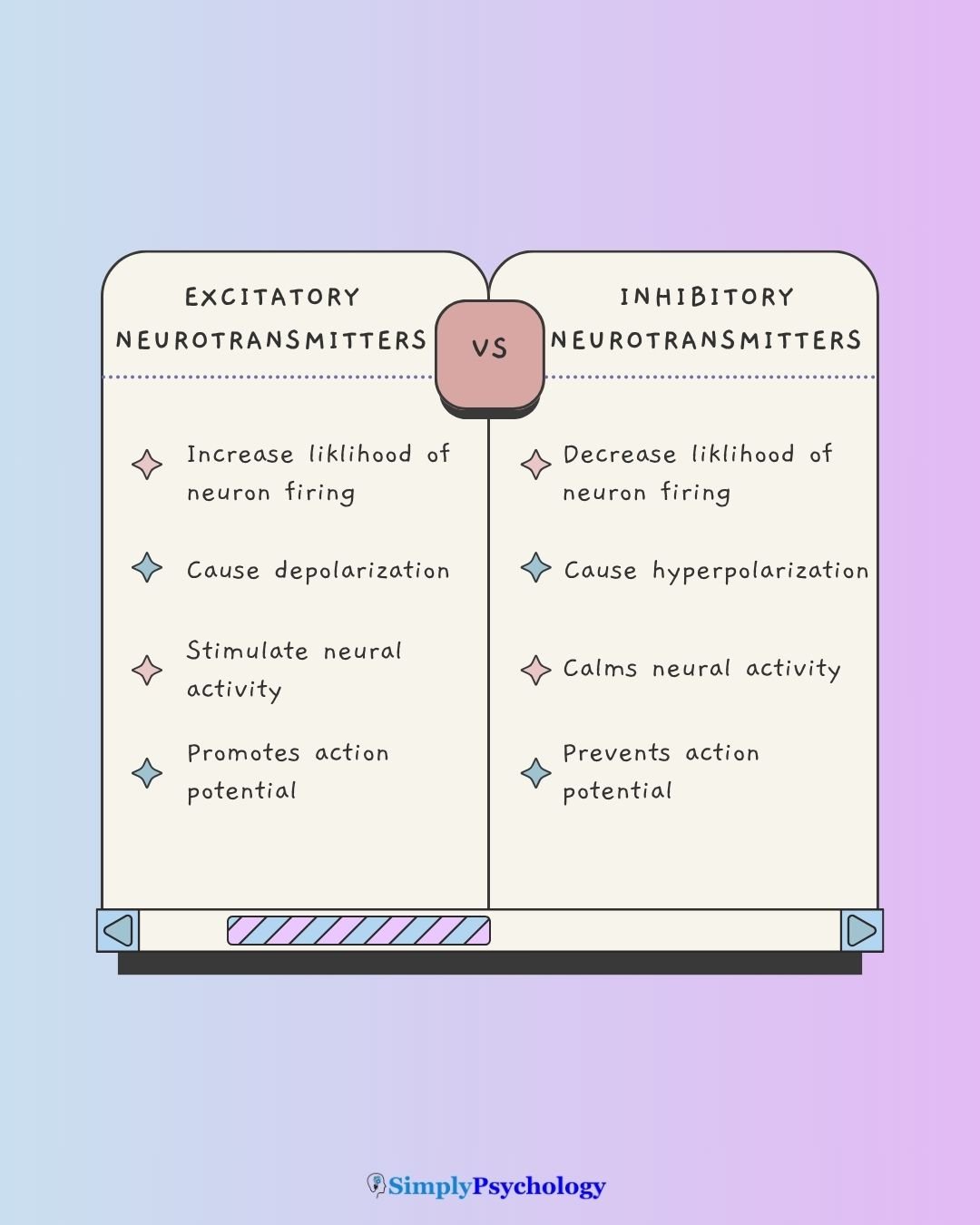Excitatory and inhibitory neurotransmitters are chemical messengers that influence how neurons communicate.
The key difference lies in their effects on the postsynaptic neuron:
- Excitatory neurotransmitters increase the likelihood that the neuron will fire an electrical signal.
- Inhibitory neurotransmitters decrease the liklihood that the neuron will fire an electrical signal.
In simple terms, excitatory signals act like a green light, promoting neural activity, whereas inhibitory signals act like a red light, calming or suppressing it.
Both types are essential for maintaining balance in the brain and regulating everything from movement and mood to learning and sleep.

What are neurotransmitters?
Neurotransmitters are chemical messengers that transmit signals between neurons in the nervous system.
When an electrical impulse reaches the terminal button of a sending neuron, it triggers the release of neurotransmitters from synaptic vesicles into the synaptic cleft, a tiny space between neurons.
These chemicals then travel across the gap and bind to specific receptor sites on the receiving (postsynaptic) neuron, much like a lock and key.
The message delivered is either excitatory, making the receiving neuron more likely to fire, or inhibitory, decreasing that likelihood.
Neurotransmitters are crucial for virtually all nervous system tasks, maintaining vital brain and body functions.
Excitatory Vs inhibitory neurotransmitters
Below are the main differences between excitatory and inhibitory neurons:
Effect on the neuron
Excitatory neurotransmitters make the receiving neuron more likely to fire an electrical impulse, or action potential.
Conversely, inhibitory neurotransmitters prevent or decrease the likelihood of the receiving neuron firing.
Think of excitatory neurotransmitters as gas pedals for the neuron, while the inhibitory neurotransmitters are like a brake.
Differences in Types of Neurotransmitters
Below are some types of neurotransmitters and whether they are excitatory or inhibitory:
- Glutamate is a common excitatory neurotransmitter, crucial for learning and memory.
- Norepinephrine can be excitatory or inhibitory depending on the receptor. It affects mood, alertness, and arousal.
- Acetylcholine (ACh) is involved in muscle action and memory capabilities. It can be excitatory in the brain and autonomic nervous system, but inhibitory elsewhere.
- GABA (Gamma-aminobutyric acid) is the nervous system’s primary inhibitory neurotransmitter, blocking signals associated with anxiety and affecting brain function and sleep.
- Serotonin is primarily inhibitory, regulating mood, sleep, eating, and pain.
Depolarization vs. Hyperpolarization
There are also differences in whether excitatory or inhibitory neurotransmitters depolarize or hyperpolarize.
A neuron at rest has a negative electrical charge inside its membrane (resting potential, typically around -70mV).
- Excitatory neurotransmitters cause depolarization. They allow positively charged ions (like Sodium) to enter the neuron, making the inside more positive. If this positive shift reaches a “threshold of excitation” (around -55mV), the neuron fires an action potential.
- Inhibitory neurotransmitters cause hyperpolarization. They make the neuron’s internal charge even more negative, moving it further from its firing threshold and making it less likely to generate an action potential.

How do these neurotransmitters work together?
Neurotransmitters maintain a crucial excitation/inhibition balance within the nervous system.
Both are essential because this precise balance of knowing when a neuron should fire allows for the complex, coordinated activity required for all brain and body functions.
Without adequate inhibition, neural circuits can become overstimulated, potentially leading to anxiety or seizures. Conversely, without excitation, neural activity would cease.
Examples:
- In the cortex, excitatory glutamate is vital for processes like learning and memory. Inhibitory serotonin is crucial for regulating mood and sleep.
- In the spinal cord, sensory neurons transmit information to the brain (often excitatory), while motor neurons carry commands from the brain to muscles and glands.
- Coordinated movement relies on the precise excitation of certain muscles and the simultaneous inhibition of their opposing counterparts via these signals.
Can neurotransmitters be both excitatory and inhibitory?
Yes, a single neurotransmitter can be both excitatory and inhibitory.
The message it delivers depends on the specific receptor site on the receiving neuron to which it binds.
For instance, norepinephrine can cause either excitation or inhibition depending on the receptor.
Similarly, acetylcholine is excitatory in some brain areas and the autonomic nervous system, but inhibitory in others.
What happens when there’s an imbalance?
When the delicate balance between excitatory and inhibitory neurotransmitters is disrupted, various neurological and psychological issues can arise:
- Overexcitation: Too much excitatory neurotransmitter activity, or insufficient inhibition (e.g., of GABA), can lead to overexcitation. This can manifest as seizures, which involve uncontrolled neural firing, or increased anxiety and panic. For instance, panic attacks are linked to abnormal norepinephrine activity in the locus coeruleus, which triggers the body’s fight-or-flight response.
- Too much inhibition: Conversely, excessive inhibitory activity can result in sedation (e.g., from drugs that enhance GABA neurotransmission).
Role in different conditions:
- ADHD: Is associated with differences in the frontal lobes, an area rich in dopamine. Stimulant medications for ADHD increase dopamine activity to improve impulse control and attention.
- Epilepsy: Characterized by seizures, which can be linked to issues like the large-scale loss of the myelin sheath on axons throughout the nervous system, interfering with electrical signals.
- Schizophrenia: Is often attributed to an overabundance of dopamine or too many dopamine receptors, particularly in the limbic system, contributing to symptoms like hallucinations and delusions. Imbalances in serotonin and glutamate are also implicated.

